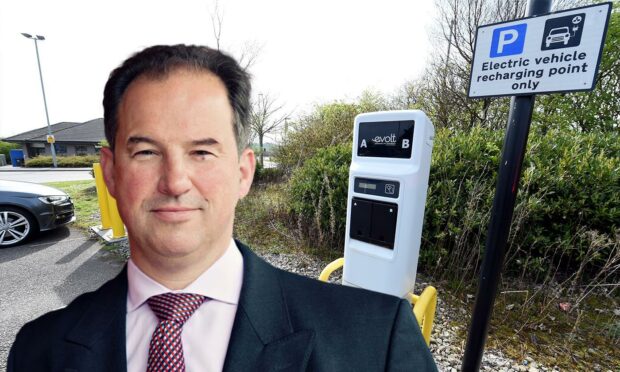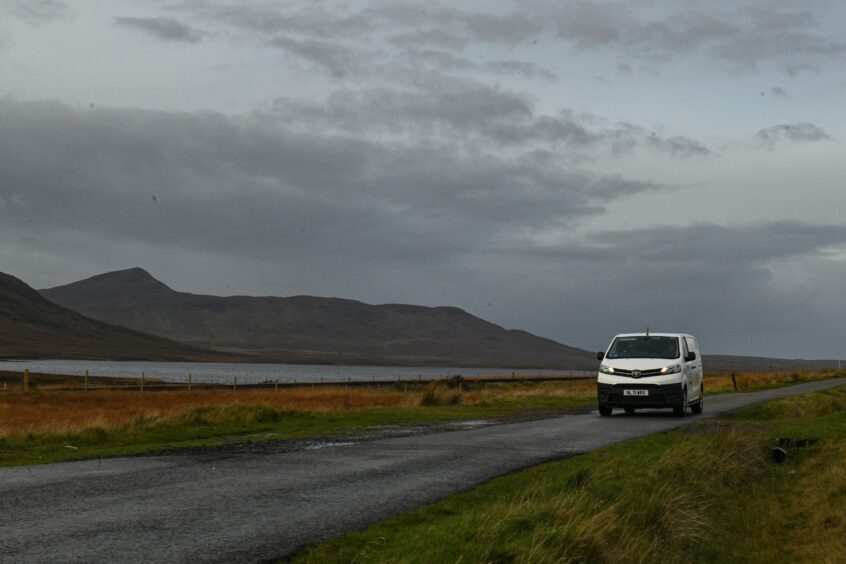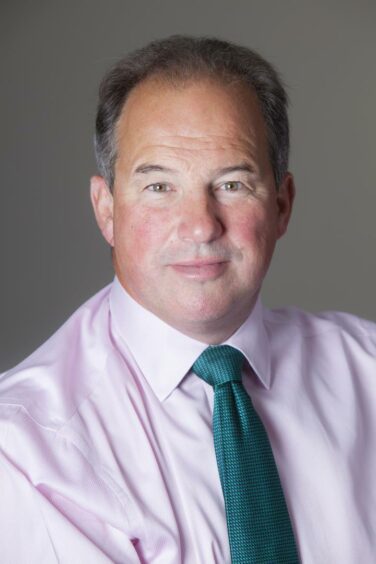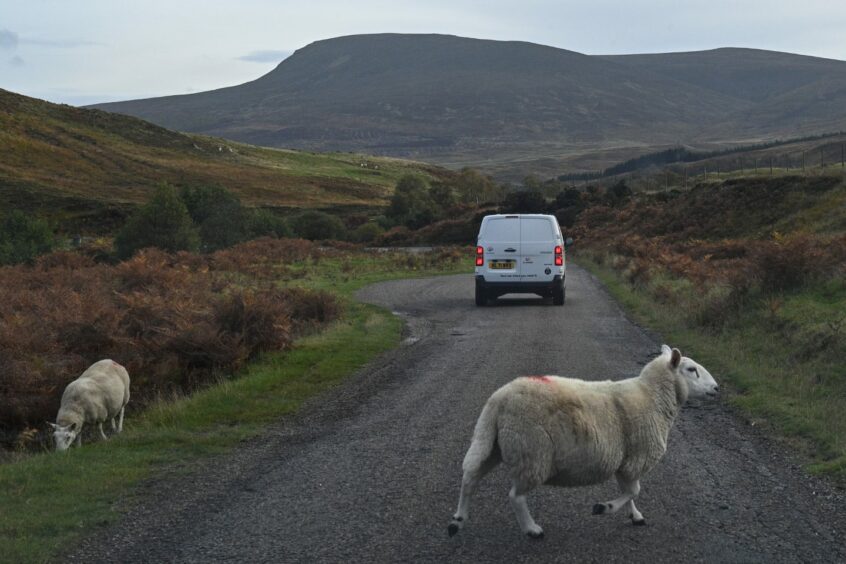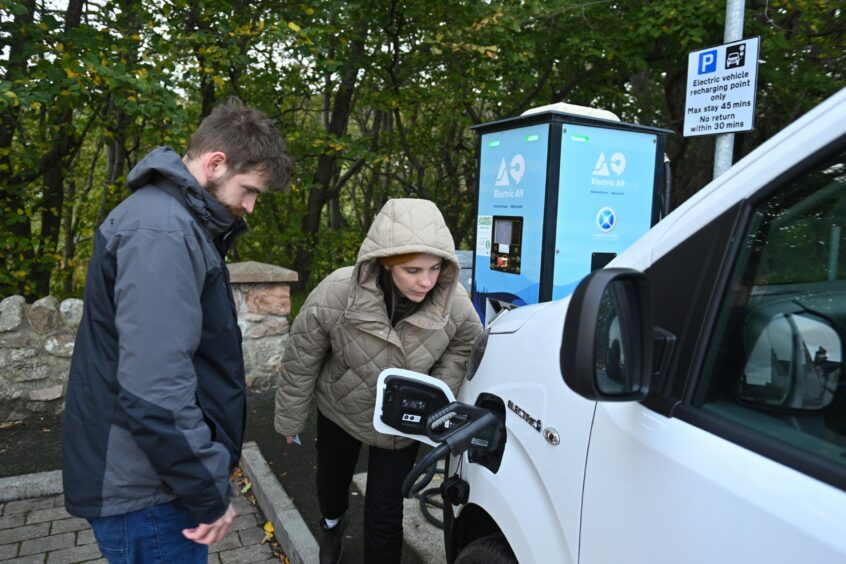Electric vehicles are fine for “pottering” tourists but without efficient charging points “right up the glens” businesses won’t be able to afford going green, says the president of the Scottish Chambers of Commerce.
Tim Allan, who is also a director at Motor Fuel Group (MFG), spoke with us about the impacts of moving away from fossil-fuelled transport after the Press and Journal’s reporters took an electric van from John o’Groats to Aberdeen, and experienced all sorts of challenges along the way.
‘The ambitions for electrifying and going green are all there’
Earlier this year MFG announced plans to invest £400 million in ultra-rapid EV chargers across its network of more than 900 forecourts across its UK .
As part of these plans, around 3,000 such chargers are set to be installed at 500 of its sites by the end of 2030.
Tim explained MFG is experiencing a “50% increase month on month for the number of charges that we expected”, and said across the country, “the ambitions for electrifying and going green are all there”.
But in order to get more people and businesses to go electric, Tim believes the private sector will need to play a key role, but that the government should do more to ensure the potential for the technology is available all over Scotland, for both rural and urban communities.
Tim touched on the Press and Journal’s EV journey from Aviemore to Peterhead, which was delayed due to required charging points on the optimal route being occupied or broken, as an example of how he thinks Scotland’s charging point infrastructure needs improving in order for the business world to get on board.
Our road ahead… this section of the north-east is rubbish for rapid charger availability so we've got to be as efficient as possible #ClimateRoadTrip pic.twitter.com/WCMqMqOOZa
— Kieran Beattie (@KNBeattie) October 23, 2021
He said: “You guys had to drive across to Peterhead. What you did was allow a long time in order to do all your charging on the route, to get to Peterhead in time, and even then you were two hours late because of all the closures and so forth.
“In the business world, which operates on a just-in-time supply chain, you’re going to have to change the speed at which we do business.
“This is anti-competitive compared to our competitors across the world.”
‘We are nowhere near the infrastructure required’
After two broken rapid chargers in Keith then Huntly, we're plugged in at Inverurie! Quite the diversion for our planned route to Peterhead but no other options unless we wanted to run out of juice, as we were down to about 25% #ClimateRoadTrip pic.twitter.com/Jd6T9F9GD0
— Kieran Beattie (@KNBeattie) October 23, 2021
He added: “For people trying to do business in Scotland who want to move to EVs, we have nowhere near the infrastructure required to do that, and the private sector doesn’t have the money.
“So the First Minister needs to put in serious power generation, and serious power distribution all over Scotland, right up the glens.”
Tim said he has discussed the topic of EVs on social media, and noted a discrepancy between those using EVs for leisure and tourism, and those who need to get around speedily to ensure their business is profitable.
“People have said to me on LinkedIn, I went around the Western Isles over two weeks in an EV with no problem at all,” he said.
“If you’re pottering about the west of Scotland in your car one summer, well that’s up to you.
“What I care about is a timely, efficient, and cost-effective supply chain which means businesses in Nigg, in Inverness, and in Argyll and Bute can function and compete with international competitors.
“EV in Scotland currently doesn’t do that right now.”
‘You need to have that incredible power capacity of hydrocarbons for the time being’
Although his company MFG is investing in electric, Tim believes the future of transport in Scotland will still require the use of fossil fuels until the infrastructure for EVs gets better.
“EVs are certainly part of the fuel mix for the future,” he argued.
“The fuel mix of the future needs to continue to have petrol and diesel because for Scotland, you need to have that incredible power capacity of hydrocarbons for the time being, until we get a reliable network.
“Electric is part of that future, hydrogen will be part of that future particularly for heavy vehicles like lorries, buses and trains.
“But for all that to happen, the really big thing is the government needs to involve the private sector and be spending many hours of political capital and financial resource in getting the country geared up for the electric vehicle revolution, which I don’t think it’s doing at the moment.”
Scotland ‘already leads the way’ on EV infrastructure, says Transport Scotland
A spokesman for Transport Scotland argued that Scotland “already leads the way on electric vehicle charging infrastructure”, and said Scotland is ahead of the rest of the UK.
He said: “The latest figures show that Scottish electric vehicle drivers benefit from almost 40 public charge points per one hundred thousand people, compared to fewer than 30 in England, just over 20 in Wales and less than 20 in Northern Ireland.
“We’ve invested over £50 million in Charge Place Scotland which now has almost 2000 publicly available charge points.
“We provide funding to all of Scotland’s local authorities to make sure communities across the country – urban and rural – have access to the benefits of EV charging.”
The spokesman also highlighted the Electric A9 project to develop “multiple EV charge place hubs along the route”, and pointed to funding provided to support the installation of “more than 10,000 domestic and workplace chargers across Scotland”.
“This includes almost £10 million to Scottish businesses to help install EV charging,” he added.
